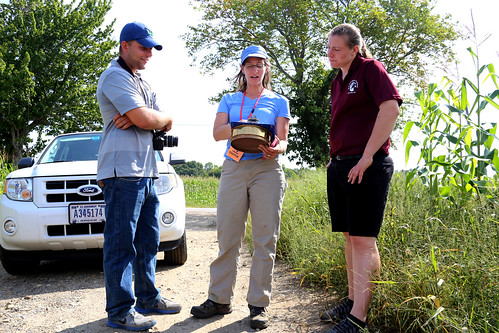
Samantha Whitter represents the fifth generation at Whittier Farms in Sutton, Massachusetts. Her family’s 500-acre, 100-head dairy farm is one of the largest in this small town 10 miles south of Worcester—the second largest city in New England, after Boston.
Samantha’s dad, Wayne Whittier, signed up for aerial cover crop seeding offered by USDA’s Natural Resources Conservation Service (NRCS). The conservation practice involves a helicopter swooping over corn fields, releasing winter rye seed from a hopper swinging beneath the chopper. To a bystander, it might look like an air show or a crime scene investigation, but it’s actually a very controlled seed application that uses a Global Positioning System (GPS) to track the helicopter’s flight path and precisely map where seed was distributed.
With a retail farm store that’s open daily and fields that are visible to their neighbors, the Whittiers knew that some public education was in order.
“We wanted to use this opportunity not only for the conservation benefits but also as an educational tool for the public,” said Samantha Whittier. “It helps to show people what modern agriculture is all about,” said Samantha Whittier.

“So we took to Facebook right away. Two weeks prior to the helicopter coming, we put up a post letting people know what it was and that cover crops can help with soil erosion and runoff,” she explained. “Being so close to local ponds and lakes, we wanted to push that this is helping the environment and it's helping us as farmers, too.”
“Social media, thankfully, is really responsive, so as soon as the pilot called and said he's on his way, we put it up on Facebook and we had a great response.”
Earlier that summer, staff from the NRCS field office in Holden had provided program information and conservation planning help.
“We offer cover crop under the Environmental Quality Incentives Program,” said NRCS Soil Conservationist Robert Purcell, referring to financial assistance available through a 2014 Farm Bill conservation program. “This is the first time in about 25 years where cover crop was offered aerially.”
Purcell explained that rye is inter-seeded into the corn so that when the corn is harvested a few weeks later, the cover crop is already established. If producers apply a cover crop after they harvest their crop, it can be too late in the season for it to establish well enough to provide the full benefits.

“The benefits of a cover crop are multi-fold,” said Kathryn Zichelle Sullivan, also a soil conservationist with NRCS. “It helps to hold nutrients in the soil, it can help build organic matter, which helps hold water through dry periods. It also stimulates beneficial microbial activity.”
“One of the big principles of soil health is to keep something growing on the surface of the ground at all times,” said Sullivan. “The cover crop is keeping the ground covered in the fall, winter, and spring.”
Whittier described how the aerial seeding worked: “The seed had come in a couple days before, so it was already in the field. The helicopter landed and the ground crew loaded the seed into the dumping bin. They hooked the seed basket in, dropped the seed, and that was it. It took about two-and-a-half hours to seed a hundred and twenty acres. It's really quick, something that would have taken a couple days of our labor.”
While aerial seeding isn’t new, the GPS technology is a new enhancement that makes the practice more efficient and effective.
“In years past, we would have had to get the crop off and then get right on it to put the cover crops down. We don't have to do that this year. It's already there,” said Whittier. “This isn't farming like Grandpa used to do.”



